In a bit of a thought experiment and after an invite by a friend, I decided to enter the English BSF Trios tournament downtown this weekend. There’s a couple of things that I should probably mention before I even begin talking about my experience. I don’t actually own any English decks whatsoever. My locals are mixed, so I have experience playing some of the English decks. Even then, not all the most prominent decks were played each week. Shoutouts to Sincere for letting me borrow his playset for the weekend.
First and foremost, a big question likely on people’s minds and surprising folks at the event was “why Arifureta?” I had entered into trios with my boys, Ciki who I have mentioned on this site and his brother that Ciki paid five dollars to join in (Kironto). Both Ciki and Kironto’s decks were far more modern, so in my most honest opinion, I was the one with the “weakest” deck out of us three. Ciki was rocking NIKKE while Kironto was on Chainsaw Man.
I’ll be very honest here. I care very little about Arifureta. I have not watched the show, and I did do some prior research into the series when it was first airing. I’ve seen clips, and sorry for you fans out there, but I don’t think there’s any redemption for you after what happened in the Tio full-dragon form scene. I really do think of Arifureta as trashy isekai.
From the last EN event I had attended, I had brought a Power deck from Chainsaw Man which I thought would do pretty well. The theory was that a strong powerful finisher that could almost guarantee the game would fare well in the tournament setting. I ended up being quite wrong as the deck fell apart at the seams with a rough early-game and low recovery tools.
This time around, and I particularly thank Ciki and Kironto for this, after some deliberation, I settled in on a new theory. We would exploit weaknesses in the meta decks and punish their inconsistencies. From our point of view, there were four decks that needed to be considered: SBY (Bunny Girl), NIK (NIKKE), 5HY (Gotoubun), and SDS (Seven Deadly Sins). We also considered BD (Bang Dream) after mirroring and observing JP lists, but it was difficult to get any data considering this would be the first major EN event for the newly printed support. We had also taken into accounts of lesser played sets such as OVL, HOL, and RWBY. To put it bluntly, we had spent some amount of time gathering information and condensing data together. I’d like to publicly thank Avis and her WeissTeaTime site for helping us gather this information.


For the SBY matchup, our thought process was to target, punish, and deny the memory generators that needed reverses to go to memory as condition pieces for the level three finisher. This was important considering many of these pieces also double as filter for the decks themselves. In order to facilitate this, we had various tools in both our CSM and ARI decks.
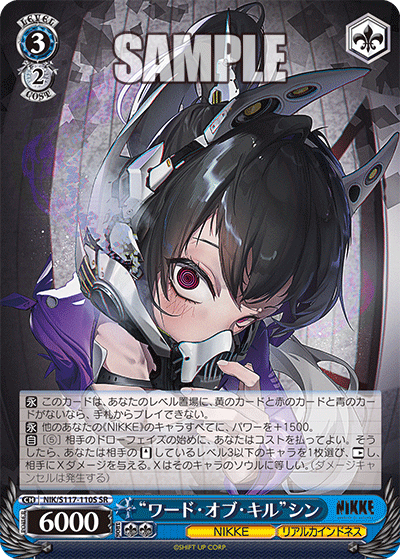
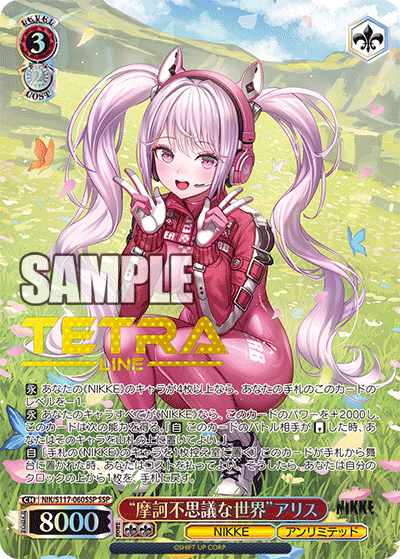
NIK/S117-060SSP-SSP “摩訶不思議な世界”アリス (right)
For the NIKKE matchup, it was imperative that we dealt with both Sin and Alice who functioned collaboratively as the deck’s mid to endgame. Both my ARI deck and my friend’s NIK deck had been set up with various responses to the NIKKE matchup. This was, however, a much more difficult match-up to work against. For my deck, I had a proactive way to deal with the combo. With a copy of my own level assist and two level three Kaoris, Alice had no way to pierce through my early play walls. They had to spawn in a second copy of Sin, but that itself was a difficulty because they’d be reliant on multiple standby triggers. All of our decks had reactive anti-change counters but because of the nature of standby, there was always the possibility that our opponents could just respawn their field again for the cheap.
For the other decks, there weren’t any particular counters that we thought we could put in to deal with those match-ups. We did note that SDS had a rather low powerline and many of their cards were level zeros with lacklustre power during their opponent’s turn, a weakness that really only my deck could take advantage of. Nino was virtually untouchable, and despite being a standby deck, could hardly care about maintaining board. Overlord was another light concern, but the recent bannings would have hampered its success. We still respected the match-up and kept it in mind.

Without further ado, this was my deck. You can view the full deck and its cards here on DeckLog. For my partner’s lists, you can take a look at Avis’ WeissTeaTime lists. There were two major goals in entering this tournament: 1.) I wanted to show and prove that you can maintain a full themed deck and still produce results, 2.) I wanted to punish my opponents’ meta piles. Arifureta met this exact niche. There were three main synergies I was counting on to be able to accomplish my goal in the latter objective.

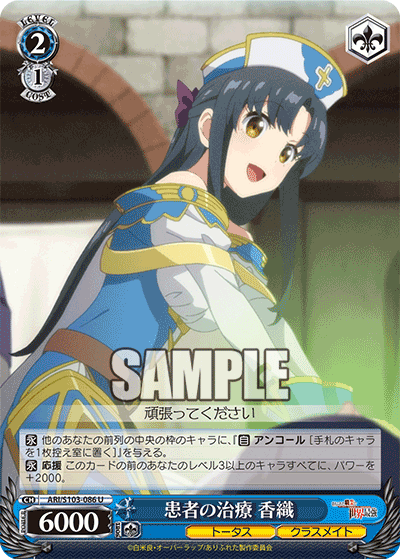
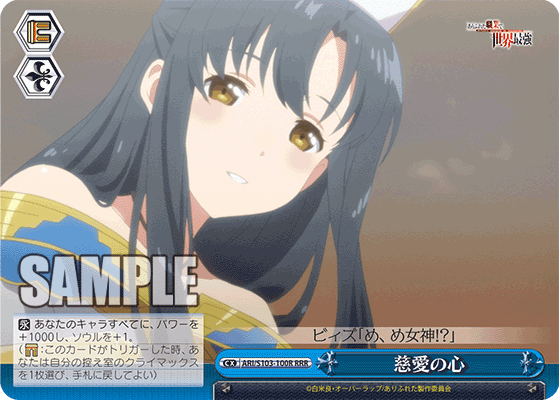
ARI/S103-086U 患者の治療 香織 (center)
ARI/S103-100R-RRR 慈愛の心 (right)
The first and most important synergy was the need to bring out 3/2 Kaori shown above. Kaori, in my perspective, is not a very powerful card. I play in the Japanese meta, and all my early plays must provide some amount of value beyond simply being a large beatstick. Kaori, in most cases, would be a card I would never consider in my decks. However, given the state of the English meta, and the need to have large powerful beaters to beat over some of the power matchups like NIKKE, Kaori was the perfect piece. I was in deep consideration over the number of copies of the 2/1 assist to run. This card was good, but in certain matchups, it was unneeded and unnecessary. It would come to be of great importance in this tournament.
Having the 2/1 assist effectively locked Kaori on board. Many decks in this tournament struggled to beat over them. NIKKE players had to respect Kaori. Considering that my deck also ran the 1/0 Hajime anti-change, attempts with any oversized early play charge could be, in theory, dismissed entirely. In the other matchups, the 2/1 was more or less useless. For example, in my first game, and bless your soul for playing Dragon Maid, my opponent could just never get over two Kaoris in general. The backrow assist was just not needed.
Arifureta is an old set. And I knew this coming into the tournament. I had not much practice with other English sets. I could, in theory, bring back a JP set that I knew had come to EN. But I wanted to try something new, and my old decks would not fare quite as well in this meta. Kaori’s condition to come out early was both relatively easy and an annoyance depending on the RNG of the game. In some cases, it was already given to me by my opponent’s swing. In other cases, I had to force it myself.
Either way, if I was given a turn or two at level two, I could virtually heal down to 2/0 and my opponent would sit there frustrated, struggling to get over the walls while failing to deal any significant amount of damage. This was my game plan for the most part.
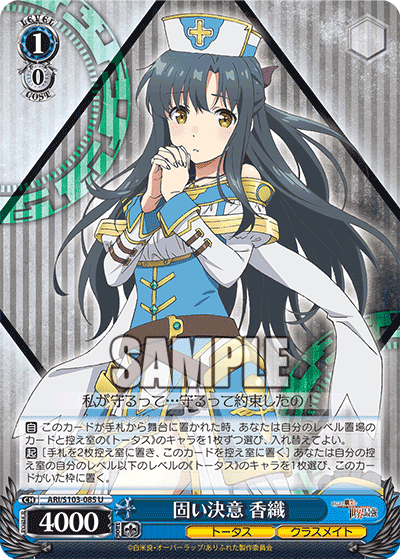
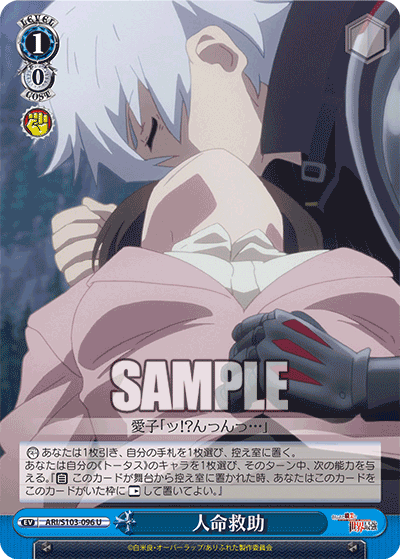

ARI/S103-096U 人命救助 (center)
ARI/S103-080S-SR 【剣士】雫 (right)
I had a number of other tools to add consistency or to keep Kaori alive. The 1/0 Kaori was just a way to guarantee that I had the condition to early play the 3/2. In addition, it’s secondary effect was to change itself into something that was my level or lower. In every game, if I had to use its secondary effect, it was almost always the 2/1 assist. The 1/0 event was not as impactful as I had hoped. This was also partially expected. With my deck, my early game board is abysmal. 1/0 Shizuku sits at cross-turn 2000 power, meaning any level zero could just punt her over. She was probably the best card to keep alive, considering all my other cards in the early game just don’t provide much outside of their on-play abilities. The primary purpose of the event was really the extra draw and discard, hoping to loop into the climax to continually heal down with 3/2 Kaori. In a few cases, when my opponent managed to beat over Kaori, I could just use the event and completely undo their hopes and dreams. 3/2 Shizuku was a way for me to close out the game and grab back the climax to heal again, but most of my games never really reached a point where I wanted to use her. Furthermore, my walls worked in an anti-synergistic way with Shizuku as my opponents would flail their cards into Kaori to begin with.
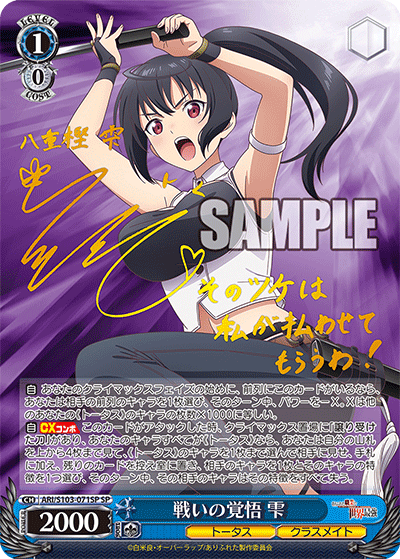
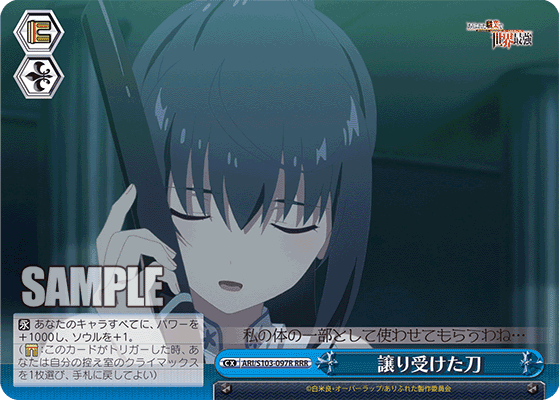
The next major piece of synergy was that of Shizuku here. Shizuku was most important, ironically, for its first ability rather than its combo ability. The theory was that Shizuku could melt my opponent’s fields down and then allow my cards to swing directly, dealing massive amounts of damage. Keep in mind that this resolves with or without a climax. She also had a combo, which helped with refunding hand while also knocking out a trait and milling the deck. The trait killing does have some importance as you can potentially kill cards that are entirely reliant on traits for power like 1/0 Modernia coupled with the minus power from the first ability. Shizuku does have very low power for a level one card, making it often very difficult to get over certain boards, especially against standby decks. However, the focus is to take advantage of the chaotic early game and push your opponent heavily by murdering their level zero board.
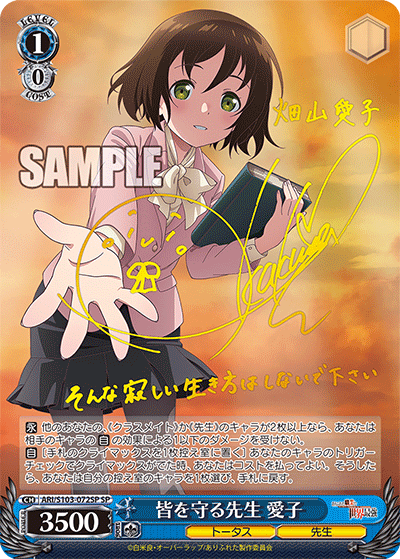
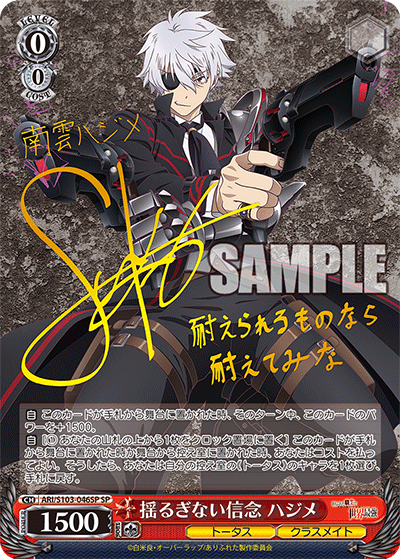
The last synergy was that of the early play conditions needed for 3/2 Kaori. Both cards shown above are notoriously known to any Arifureta player or any player who has seen the series in play. The 1/0 Teacher is infamous for her anti-ping one ability while 0/0 Hajime was considered an extremely strong double Riki profile both on play and when sent to waiting room. The 1/0 Teacher was an awkward card in most meta lists since blue was a lesser played colour. She also rarely got her first ability off since she checked for specifically two traits of either Classmate (クラスメート) or Teacher (先生). The cards that feature these traits are limited to those of Hajime and his classmates before they entered the isekai world. Many decks rarely ran enough cards to fulfill her first ability, and for this deck, I wanted to capitalize on that effect. It is also a passive ability, meaning you don’t really need to put much effort into doing anything and given that almost every card fulfills requirements in my deck, you would never have to worry about failing the condition. 0/0 Hajime is self-explanatory in its use. It’s ability to be used twice on a single card gave you unparalleled access to hand from your waiting room.
In practicality, the 1/0 Teacher was okay at best. It didn’t do much for a majority of match-ups with the only ones that really mattered being NIKKE and my first match with Dragon Maid. It was instrumental in shutting off 3/2 Tohru since my opponent didn’t have enough resources to pay the cost to declare a number other than one. NIKKE’s was a toss-up, but only during the last match where I had already essentially burned all my resources and lost out on the teacher did my opponent’s 3/2 Modernia deal a single point of damage with the random Icy Tail ability. Still, it does occasionally come up, and in certain cases, it is instrumental and can prevent all kinds of small bits of damage.

In practice, outside of a single game where both my opponent and I were just scrambling for playable pieces, the only decks (including that game) I lost to were NIKKE. This is awkward considering the focus of my deck was to beat decks like NIKKE by overpowering them with 3/2 Kaori. Being able to beat over the likes of Alice and prevent my opponent from establishing board dominance was key to breaking the matchup. However, despite what I had planned, there was one key card or rather mechanic that prevented my plan from continuously going through. And that was, of course, that of the standby trigger. You see, even if I could continuously beatdown on my opponent’s board, NIKKE had one particular advantage that I could never overcome. Essentially, every Alice I would punish would be replaced by another who was just freely spawned from their waiting room through a single trigger. It was a war of attrition, but the opposing side had unlimited reinforcements assuming they could continuously trigger the same power button again and again. This was particularly problematic in one matchup where my opponent was essentially out of luck and unable to topple 3/2 Kaori had it not been for his ability to spawn an additional 3/2 Sin on stage just during the swing. Given the assortment of tools and especially that of 0/0 Rapi, my opponent could fairly much guarantee the standby trigger when needed to, making the matchup much more difficult.
Granted, both my losses to NIKKE were quite evenly matched if I would say so myself. My last match during top eight ended rather sadly. I had already been burnt out of resources long before, having very few climaxes left. My opponent continued to maintain advantage even up to the very end, which was still a potential coin-toss. I had one more turn left to finish my opponent, but given Arifureta’s card pool and circumstances, there was no way for me to prevent the use of 3/2 Modernia’s yellow event, resting one of my characters and denying 3/2 Shizuku’s finishing ability. Yes, I do have 0/0 Kaori, but I had no way to grab it during the turn.
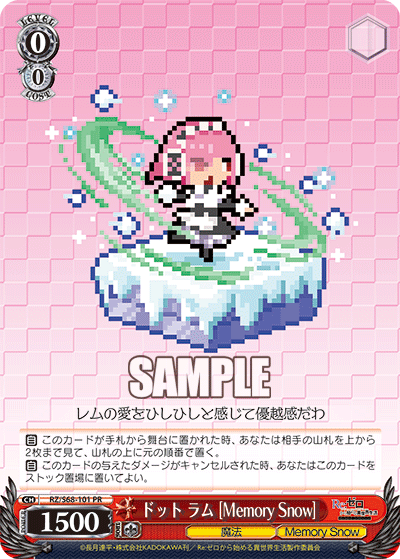

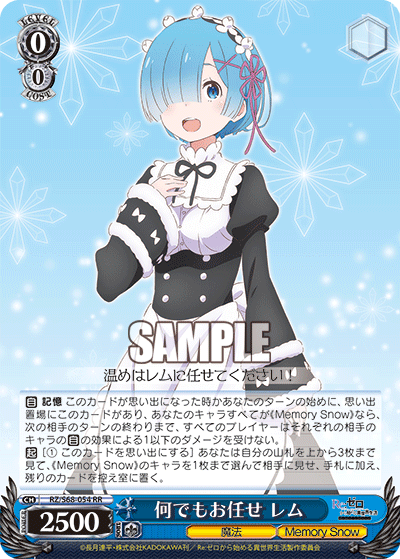
RZ/S68-058S-SR 楽しい宴会 レム (center)
RZ/S68-054RR 何でもお任せ レム (right)
One of the most interesting matchups I did have was that of a player with Memory Snow Re:Zero. I would like to give props to the player (I forgot to ask their name). They had told me their goal was to make standby decks miserable, and in the previous round, they had heavily punished a Nino player. I immediately shook hands with that man since it’s rare to find someone with such high culture. Their theory was, in my opinion, quite close to mine, making a deck whose main synergy flowed well with punishing some of the meta plays in the game during that time. However, this was exactly one of the problems that could backfire. He had thought I was playing some sort of standby hybrid which I had learned during that round was one of the more popular Arifureta builds (I didn’t even know this series had standby). His gameplan had lost efficacy simply because my deck was simply not a standby pile. In all fairness, I think I ended up just edging on top due to luck and quite simply, card quality.
Re:Zero, and especially that set of his, Memory Snow, is quite dated. My series was three years newer than his, and on top of this, I believe Memory Snow entered the EN game in a delayed way long after its relevance in JP had subsided. Furthermore, due to the ways in which Memory Snow functioned, it had its own locked card pool within its own series. I had simply better card quality, and this was an important factor to note. It didn’t come up this game exactly, but with older cards, the general power ceiling (the literal printed power on a card) is rather low. This gives my deck much more advantage as 1/0 Shizuku can take this account and easily snipe away field to allow me to push for more damage. In the early game, I was out quite a lot of CXs, but I didn’t know my opponent’s hand (he later explained to me) was also not in a good spot. Additionally, while Shizuku could check up to four, his level one combo, Rem, could only reach three at most which mattered heavily when it came to card selection.
It was also a bit funny when we both revealed our anti-ping one game plan with his 0/0 Memory Rem and my 1/0 Teacher only to realize that neither card mattered in this matchup whatsoever.
I essentially stabilized at level two and healed down while my opponent couldn’t touch 3/2 Kaori. Rem couldn’t catch up in damage. Honestly, whomever piloted this deck. You’re a solid player and a cool dude; I would love to play again with you another time.
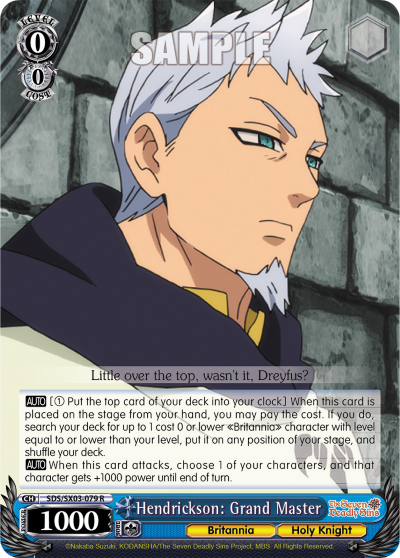
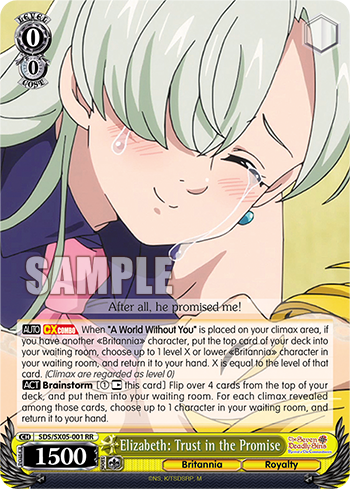
One matchup where my theories were proven correct was that of Seven Deadly Sins. I have rarely played against this deck at locals. I don’t know too much about it, but I surmised with my squad that the deck plays a very value-based low power game with a high amount of level zeros. Given that 3/2 Hendrickson can’t really be interacted with and doesn’t care about trait or anything, the matchup felt more like solitaire. However, I was able to make use of my opponent’s rather low power board. 1/0 Shizuku quickly mopped up my opponent’s row, which with a bit of luck, made it rather easy for me to stick large amounts of damage onto my opponent before they were able to set-up. I was also hit rather hard by 3/2 Hendrickson, but I managed to survive the game-finishing turn and swing back to close it out.

One card that really surprised me this tournament was that of 2/1 Fumio profile, Aiko. My decks don’t usually have a copy of Fumio, and in my opinion, it’s use is rather niche as well. However, for two of my matches, the profile came in clutch as my opponent managed to end their turns with a rather compressed deck. Being able to reduce the number of cancels and clutter up their decks made my vanilla swings much more deadlier than they would otherwise. Given that my only actual finisher is 3/2 Shizuku, I had spent most of the games really winning through vanilla swings, greatly aided by Aiko when her opportunity came to shine.

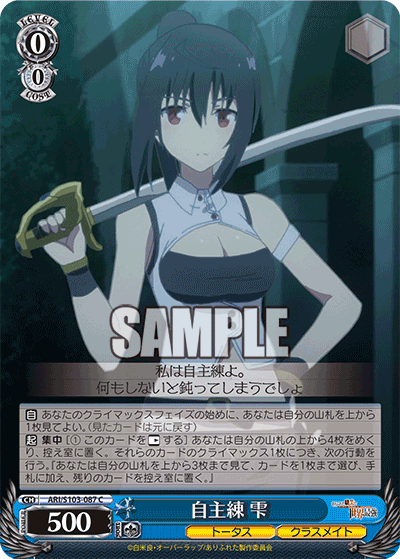
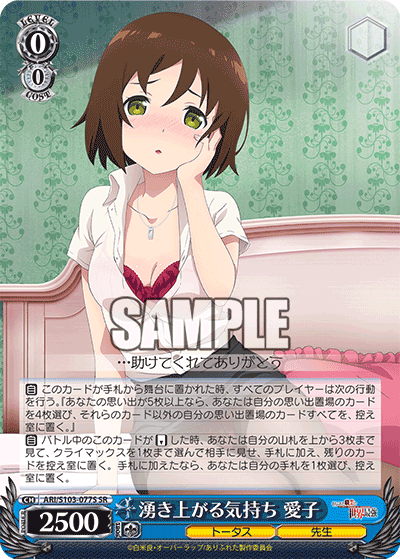
ARI/S103-087C 自主練 雫 (center)
ARI/S103-077S-SR 湧き上がる気持ち 愛子 (right)
I had quite a blast. It was unfortunate that we scrubbed out exactly during top eight, but I’m still proud of my team for making it thus far. Personal record wise, it was 4-3 (including the awkward match at round two), but otherwise, the deck proved to work fairly as much as I had expected and even more in some cases. I wish I had made better use of the anti-trait from Shizuku more as I often neglected and forgot about the ability (had to side in some cases because I forgot that). There were some misplays as well here and there.
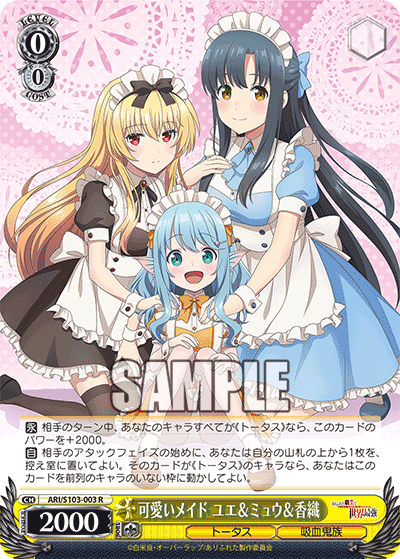
Ultimately, what I can conclude is that playing well and having a deck that works with itself rather than looking for niche inconsistent plays (such as slotting the 1/0 Teacher as a one-of) tends to make your gameplay more enjoyable and fun. Effects are more likely go off and you’ll have a better feel throughout the game. Rather than forcing every “good” profile under the sun in your deck, it is better to prioritize cards that fit well overall, and you’d be genuinely surprised about all the small synergies within archetypal decks and catered decks. Rather than looking to cover every weakness, in my opinion and based on my performance here, it is better to focus on your strengths with counterplay when your deck can afford it. Side note, the runner profile above was actually a mistake on my part when assembling the deck. I had intended the deck to be the full Classmate deck, and I saw Kaori on the card, so I immediately believed it had the Classmate trait. This didn’t end up really mattering performance-wise, but I wanted to make a slight note here.


Lastly, in conclusion, if I were to make any changes to this deck, I think they would be rather minute. I think the deck as a whole is okay, but I was more-so lucky with the meta being what it was. I think the primary issue is just how expensive Kaori was to employ on field, but given her combo and it’s power, it’s a fair cost. However, in a tournament setting, especially in modern times, you just need a better edge in advantage. Especially during my losses, I felt if I had just one more card that gave me just a little more power whether that is in utility or gaining hand or stock, I’d be able to make just slightly more plays.
Kaori burning pretty much all my stock on play and requiring the climax to do just about anything made it very difficult to compete in an environment where my opponent’s cards are simply pushing for so much soul, destroying field, or massively gathering/refunding resources. I felt that, especially during my last match, I had pretty much exhausted all the resources that I could in the deck, and I had no choice but to just accept fate for whatever it had in store. If only there was a way to reduce the costs of 3/2 Kaori while also helping maintain additional hand and/or filter for immediate needs. Here’s to hoping that maybe next year, my crew and I will claim the top prize.
Also Sincere, I will give you back your playset next weekend.